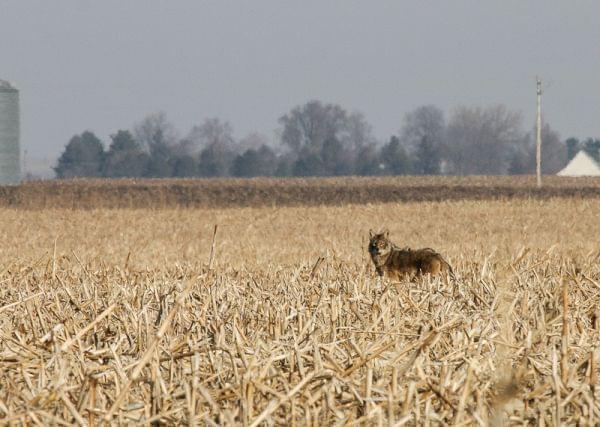Your Neighbor the Coyote

A coyote looks back at the photographer over Champaign County cornfield in winter. Rob Kanter
In the environmental writing class I teach at the University of Illinois, I emphasize that to connect with people it’s important to anticipate some of their responses to a topic. In this commentary on coyotes, undergraduate April Wendling shows how that’s done. --RK
It’s well known that human development has caused the decline of many wild species, yet coyotes are thriving alongside us. I spoke with Jean Mengelkoch, an Associate Mammologist from the Illinois Natural History Survey, and asked her why this is. She explained that developed areas have abundant food, and coyotes are great habitat generalists that can eat almost anything. They often form packs that consist of a breeding pair plus a few nonbreeding individuals that help feed and raise the breeding pair’s young. Coyotes generally hunt alone, however, unless pursuing particularly large prey. In this way, they’re very adaptable.
Owners of cats and small dogs often worry for the safety of their pets, knowing coyotes are so abundant. My mom is one such pet owner with quite a few coyote-related concerns. She tells me of her many coyote run-ins, of all the times she’s taken our dogs out in the middle of the night, only to see a coyote in the distance, “just waiting to gobble up our puppy.” Several years ago, when our outdoor cat went missing and was never seen again, she immediately blamed coyotes for it, in spite of the fact that he could have just as easily become roadkill.
The truth of the matter, however, is that coyotes very rarely eat cats or dogs. In a study by the Urban Coyote Research Program in Cook County, Illinois, it was found that cat remains were only present in 1% of urban coyote feces. The vast majority of their diet consists of rodents, fruit, young deer, rabbits, and goose eggs. In this way, coyotes can actually prevent rodent, deer, rabbit, and goose populations from growing uncontrollably. Additionally, on the occasion that coyotes do kill cats, it’s worth noting that reducing the number of feral and outdoor cats leads to increases in songbird abundance. Moral of the story? Keep your cat indoors.
Even if it was the case that my mom was correct, and that our favorite feline was killed by a coyote, I couldn’t bring myself to be particularly upset. Let me clarify – of course I loved our cat, but I certainly can’t blame a coyote if it had killed him. Coyotes, like any other predator, have no malicious intent when they kill prey or a competitor – they’re just doing what they need to do to survive.
Another common fear of those living near coyotes is attacks on humans. However, according to Urban Coyote Research Program, there have been no coyote attacks in Illinois for over 30 years. To put that in perspective, there are around 2,000 to 3,000 recorded dog bites, some of which are fatal, each year in Cook County alone. Unless given reason not to be, coyotes are fearful of humans and rarely react to us with aggression.
In an attempt to control coyote populations, people shoot some 500,000 of them each year. It seems that this effort is mostly in vain, however, because coyotes have a fascinating adaptation that causes their litter sizes to increase when their numbers decrease.
Coyotes are handling urbanization and living alongside humans exceptionally well in other ways, too. Urban coyotes have become more active at night in order to avoid run-ins with humans. They’re incredibly good at hiding, as well – one pair of coyotes in Chicago infamously raised a litter of pups inside a den in the parking lot of Soldier Field. No one would have even known said coyotes were there, had it not been for the fact that the pair wore GPS collars. Additionally, urban coyotes appear to have learned to observe traffic patterns in order to avoid being run over.
Even if you’re not ready to join the coyote fan club, I hope you can admire that.
